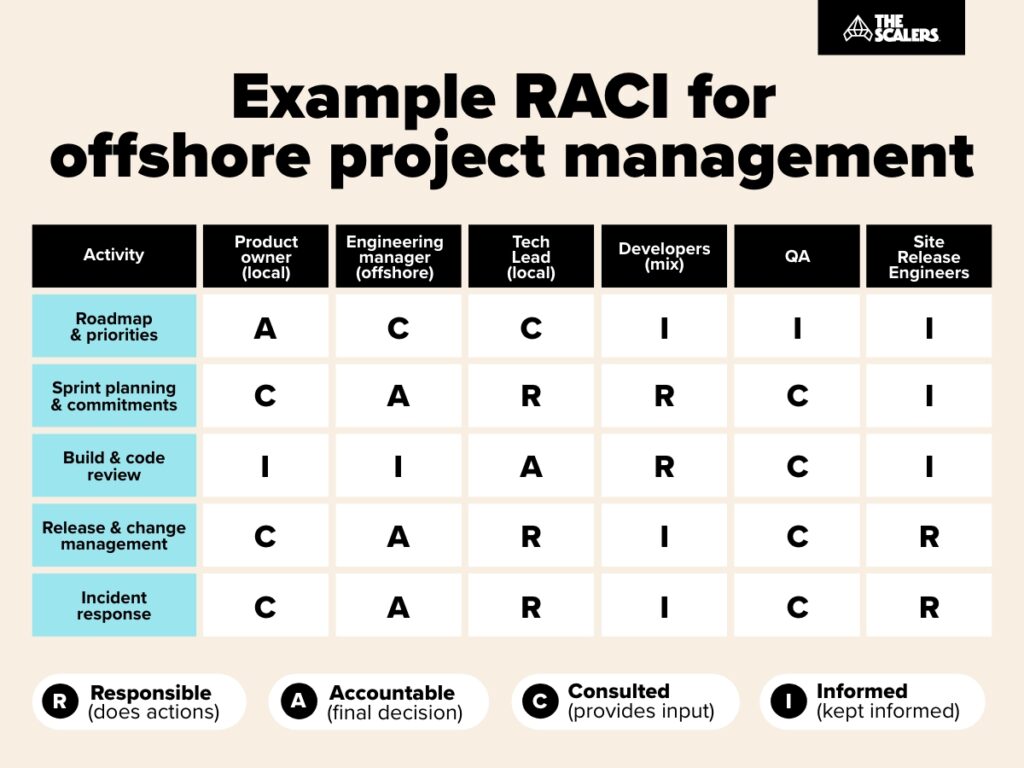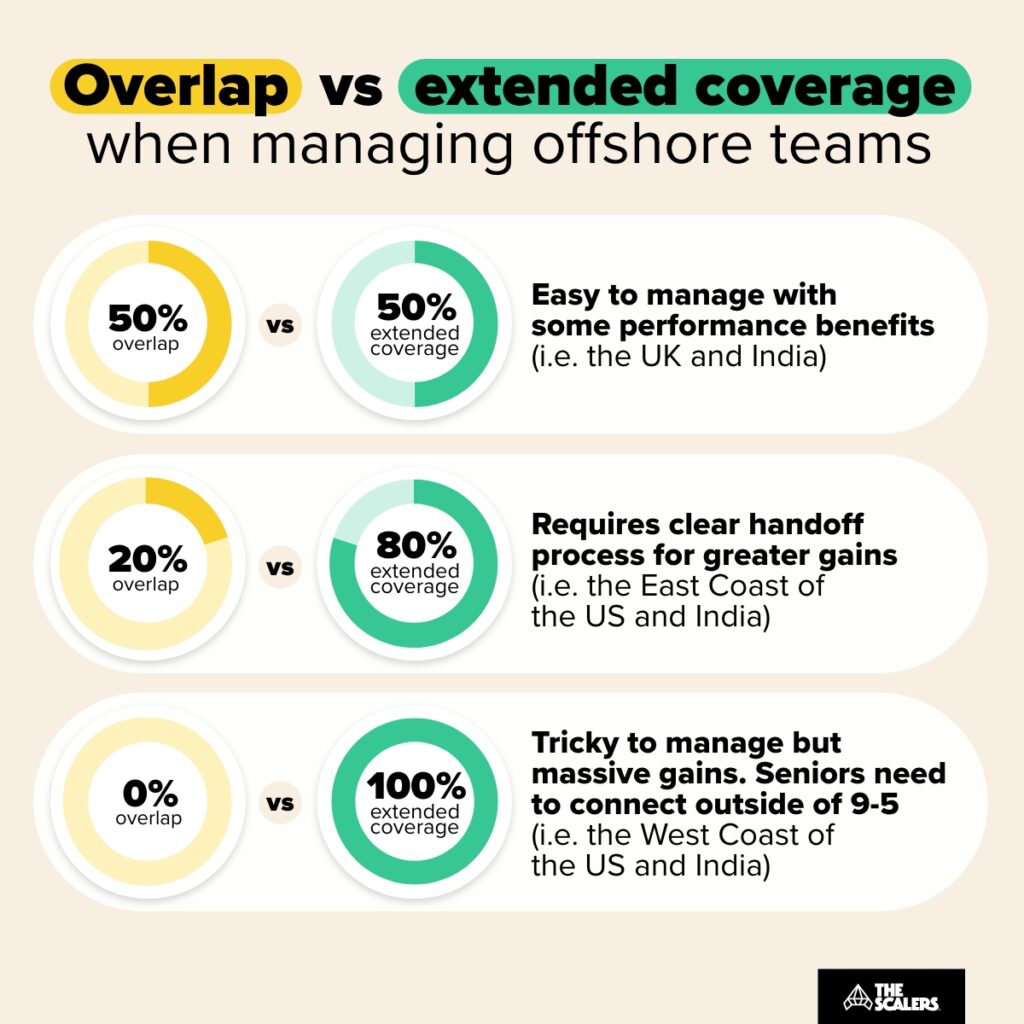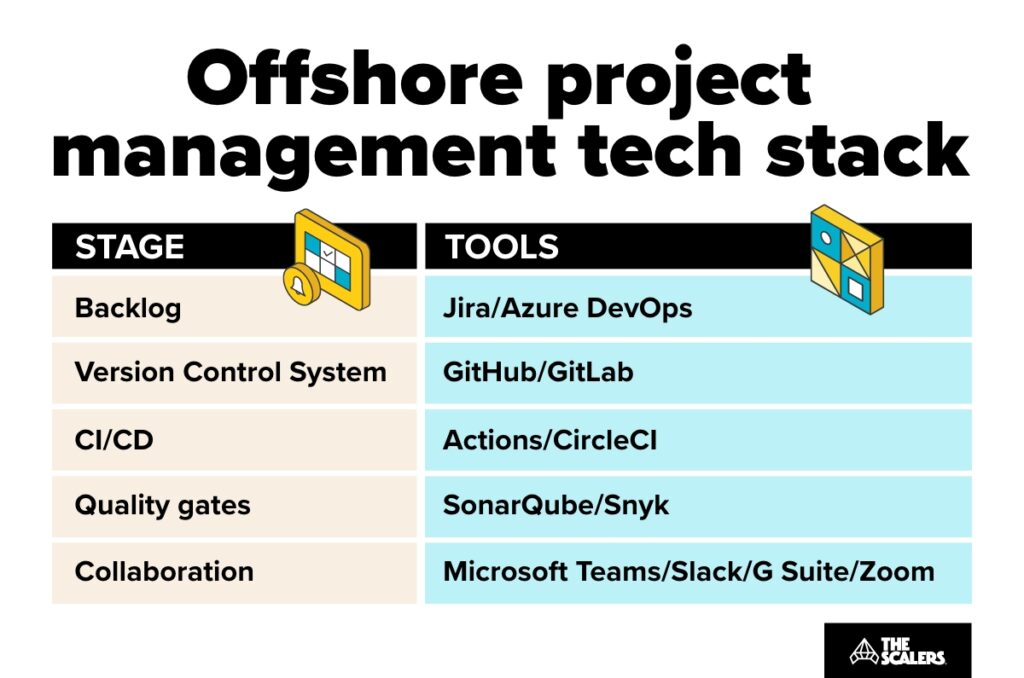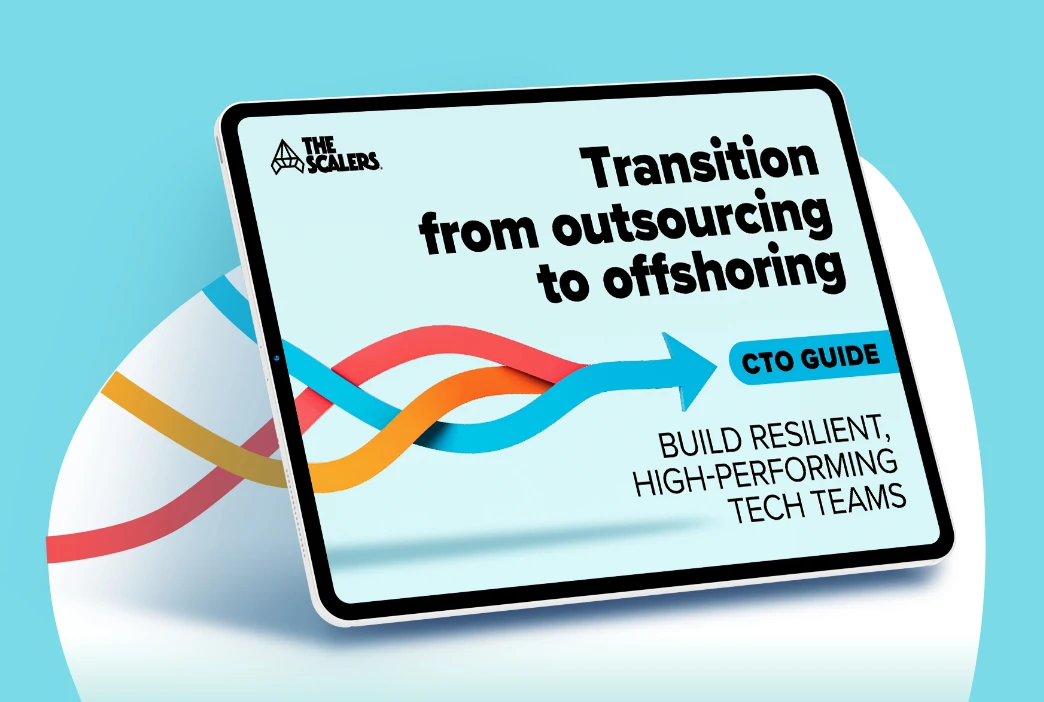Managing an offshore team is exactly the same as managing a local one, with one slight difference: they are thousands to tens of thousands of miles away.
Okay, it’s a big difference. One that magnifies all the weaknesses and challenges of a bad project management system (and is often made worse by other changes your company is likely to be going through when setting up an offshore team). It requires certain systems, tools, and practices to overcome these issues.
In this article, we’ll take you through the best practices, tools, and practical advice on how to implement them to help you set up or optimise your management systems.
If you implement these correctly, you’ll have zero issues with offshore project management (and they’ll benefit your local team too). Get them wrong, and you will probably join the string of other LinkedIn posts swearing off offshore development for good (while secretly wondering how your competitors could get it to work so well).
What is offshore project management (and why it matters)
Offshore project management is the process of planning, coordinating and executing multi-step projects where part or all of the work occurs in teams in different countries. There is no one single way to manage an offshore team; it is highly dependent on the engagement model used, the leadership approach and the offshore team.
According to a recent Deloitte survey, 77% of companies are looking to expand their IT services with offshore teams next year, with talent shortages (45%), meeting increased customer expectations (35%) and spend optimisation (34%) the top reasons cited.
When offshore projects are managed correctly, these goals are realistic benefits for any company. However, our own survey of 100 CTOs showed 85% had some concerns over offshoring, often due to prior bad experiences.
Partner-managed teams vs vendor-managed outsourcing
One of the main distinctions between how offshore teams are managed is whether they are partner-managed or vendor-managed.
Vendor-managed outsourcing is what most people associate with offshoring and the majority of challenges connected with it. When you adopt a vendor-managed model, you let your outsourcing vendor take care of managing the team while you focus on the higher-level picture. This can work for a clearly defined scope, which can be collected at once rather than through ongoing delivery.
Partner-managed teams are different. Under this model, the offshore partner sources talent and handles all the operations, HR, and culture on the ground. Under this approach, you have full control over managing the workload and processes. This means the offshore employees have direct integration within the company they work for and require daily management of work.
What factors should you consider?
From the description of these two models, you probably already know in your gut which is right for you. Either the sound of handing off the roadmap to a vendor sounds like bliss or has raised your heart rate more than watching a horror movie. There are a couple of minor points that are worth considering or at least acknowledging before you finalise your choice.
- Is this a fixed-length project, or ongoing development?
- Do you need to onboard people immediately, or is it more important to get exact talent matches?
- Do you need to scale up and down quickly, or is long-term stability more important?
- Are more boilerplate solutions okay, or do you need a team that really understands your company and product deeply?
If the first options sound more suitable, then vendor-managed is probably best for you, but if the second set aligns more with your values, you need a partner-managed team.
From our experience at The Scalers, approximately 70% of our partners had used the outsourcing model in the past but moved to a partner-managed solution later for greater integration and to focus on longer-term goals.
How organisational structures impact offshore success
After the offshoring model you adopt, your organisational structure is the next most influential factor.
If you have a complex platform with multiple teams and cross-dependencies, a flatter structure can help you manage those issues. If your offshore team is of a sufficient size and skill level, there’s no reason you can’t give them ownership and set them off on their own.
To me, typical offshoring or outsourcing is usually about cost savings and not scaling. I wanted a properly distributed model where we have a true team, where I have control over all my engineers and can scale when needed. We now have this in place, and it is working very well. — Nishant Menon, CTO and Co-founder, My Muscle Chef
Either way, you need to have clarity over who is responsible for what product, user base, or features to streamline workflows and ensure everyone knows the stakeholders and decision makers for any task. One useful tool to achieve this is a RACI/DACI chart.

What are RACI and DACI, and how can they help with managing offshore projects?
RACI and DACI are two systems to help clarify individuals’ roles and responsibilities within a team. When going through change (such as setting up an offshore team and scaling a development team), creating charts using these criteria can help managers and employees know who’s who and what they should all do.
RACI is a model for assigning tasks and ownership of projects. It stands for:
- Responsible: The person who does the task.
- Accountable: The person who makes sure the task is completed and at a sufficient standard.
- Consulted: Anyone whose input is required or desired before a task is completed.
- Informed: Anyone who needs to be updated on the completion of the task.
While DACI is for decision-making and stands for:
- Driver: The person responsible for leading the decision-making process.
- Approver: The person who can approve or reject a decision.
- Contributor: Anyone who provides data or insights to inform a decision.
- Informed: Anyone who needs to be informed of a decision but isn’t required to help make it.
By clarifying these roles and responsibilities, you can make sure all the required team members are kept in the loop and new team members know who needs to be consulted.
Two mistakes in offshore team structures
We’ve worked with a lot of partners who had prior negative experiences with offshore teams, and they almost always had two issues with their previous offshore team structure and the management systems they used.
- They had a middle project management layer offshore.
- They hired junior developers first, scaling with senior devs later.
The first is a mistake because it causes bottlenecks, often means you are interacting with a person from a non-tech background, and is usually put in place due to low English capabilities among offshore developers.
The second is a mistake because they require a lot more hands-on time, onboarding, and assistance when they join. This isn’t an issue with more senior developers, as they have experience in onboarding at companies and are better at solving their own problems. That’s why we recommend hiring senior profiles first and then expanding to more junior positions, with your senior offshore engineers able to aid with their onboarding.
Core challenges in offshore collaboration today (and how to solve them)
In the age of the internet and cloud software, 90% of managing a team is the same whether you sit in the same room together or on the other side of the world. And post-lockdowns, we all have some processes in place for remote work.
That said, the last 10% matters a lot. While it’s tempting to look for a tool to fix those issues and then change your workflows to match, identifying a process to address your problem and then identifying the best tool is a better way.
So here are the top four challenges and how to address them.
Time zones and async-first workflows
Depending on where your offshore team is located, this will be a more or less significant issue. For example, a West Coast US company nearshoring to a Latin American provider may have no time difference between teams, while the same company offshoring to Bangalore, India, might have zero natural overlap.
When time zone differences are extreme, there can be challenges with onboarding and scheduling check-ins. In practice, this usually means a few senior members of a tech team taking calls outside of 9-to-5 working hours, especially during the onboarding of the first engineers.
For Site Reliability Engineers (SREs), it’s important to implement a proper follow-the-sun workflow to ensure full coverage.

Managing large time zone differences can be a real challenge, but once you’ve overcome them, you can gain a huge advantage by extending coverage and developer windows.
Communication clarity and documentation
Communication is key to any successful team, but when you aren’t able to clear things up in person, you need to make sure what and how you communicate is well planned.
Language and culture barriers (more in the next section) are easy targets for blame and not without reason. One of the ways lower-quality offshore vendors look to save on costs is by hiring devs with weak language abilities. They then have to use an offshore project manager to translate requirements to the developers. This is where so many problems start. This is why using a quality vendor who will get you top talent really helps. It’s also why a partner-managed team is better for long-term development.
But effective communication is about more than just the people involved. It’s also about how well-defined the tasks are, how effectively the project and task status are tracked, and how good the architecture and code documentation are. Using project management tools like Jira or Asana and documentation tools like Confluence, Notion, Read the Docs, and GitBook can help, but only when your team actually uses them properly.
Here’s the really good news: if you have the proper processes in place, your local team will benefit, and you will be able to handle any unexpected changes in staffing like a sudden illness.
Culture, context, and psychological safety
With a distributed team, small misunderstandings can quickly snowball and block delivery. The local team can lose trust in their offshore colleagues, while the offshore team may feel unsafe, stifling their ability to do their best work.
The solution is to create an environment where everyone feels safe to ask for clarification and challenge assumptions without fear of blame. To create this environment, you need the right mindset and practices.
If you treat offshore developers with suspicion and as inferior, they will be on the defensive from day one. That’s why it’s important to help get your local team on board with offshoring as well, so they see it as a benefit, not a threat. You need to set clear expectations about how you work so they can fit in quickly.
Practical actions you can take include:
- Documenting meeting conventions
- Setting an expected response time
- Providing code review standards
- Creating and sharing written next step lists rather than leaving them in AI meeting summaries
When your team knows they have all the information they need, can bring up issues without threat of reprimand, and are a valued part of the company, your employees will have the psychological safety they need to do their best work.
Security, compliance, and IP protection
Data protection laws aren’t the same everywhere in the world. Worse still, there have been cases of insiders stealing data and intellectual property.
The good news is that if you have a secure work environment for hybrid and remote work locally, then you have 80% of the right infrastructure in place. These include:
- Least-privileged access
- Using Multi-factor authentication and single sign on
- A secure code environment
- Proper code review and QA testing
- An established onboarding/offboarding process for employees and vendors
Like a local team, training is also critical. You can have all the right systems in place, but human error is still the number one security vulnerability.
As I’m sure you can tell, most of these challenges aren’t that dissimilar to the project management challenges you face with a local team. The biggest difference is that the effects of any faults in your processes and tools will be felt far worse. That’s why having proper processes and systems in place is even more crucial for an offshore team.
Offshore project management best practices (field-tested)
The good news (though you may feel it’s bad) is that you won’t be able to micromanage an offshore team in the same way you can a local one. Either your vendor will translate all your requirements, or you will have to give more autonomy due to geographical and time zone differences.
With the right processes in place, this is no issue at all providing autonomy (backed with accountability) leads to more motivated and productive developers.
Planning and prioritisation rhythms
Deciding on the right goals is key, and it starts with quarterly planning events. Some decision makers like to see their team in person as a way to connect and set their roadmaps. In our experience, this is unnecessary and can create the impression of the offshore team being separate, as decision makers only come to set targets. Instead, most of our partners only hold these in-person planning sessions once every year or two. The rest of the time, they do it virtually and visit their teams in between.
Once those “big rocks” are set, it’s important to translate them into sprint goals and tie them to developer KPIs. This combination provides that combination of autonomy and accountability we talked about earlier.
Make sure you keep your stories, epics, and sprint goals all in a single source of truth so everyone knows what they need to do and if they are meeting expectations.
Delegation Do’s and Don’ts
It’s strange how CTOs can be completely comfortable delegating to a local team but struggle with their offshore ones. Here are some Do’s and Don’ts.
- Do write tickets that stand on their own.
- Do pair your offshore developers with a local “buddy”.
- Do give your offshore team full access so they can deliver quality work.
- Do clearly define who is responsible and make decisions up front to avoid bottlenecks.
- Don’t depend to heavily on synchronous meetings; identify what you can shift to fully asynchronous.
- Don’t gate deployments on a single time zone; use flags and safe rollout patterns.
- Don’t give preferential treatment and tasks to your local team.
- Don’t separate your offshore team into a different queue.
Quality and reliability (CI/CD, trunk-based dev, testing)
Reliability isn’t an accident. It’s the product of a set of engineering practices. For distributed teams, this discipline matters even more due to the increased latency between handoffs. When deployed well, however, handoffs can become an advantage with work occurring while one team sleeps.
Trunk-based development allows you to ship changes in small increments behind feature flags. When paired with a CI/CD pipeline, every commit can be validated quickly. Unit tests will help you catch logic errors early, while integration test confirm components work together properly, contract tests make sure services meet expectations, and end-to-end tests will help you confirm that your code fulfils the functionality required. Using automated checks like static analysis checks, security scans, and coverage targets will help reduce code regression.
When your developers understand and use these practices, distributed teams can achieve higher velocity while still ensuring quality.
A simple quality gate checklist:
- All code behind a feature flag with a rollback plan.
- Unit tests for new logic; contract tests for service boundaries.
- Static analysis and SAST pass (e.g., SonarQube/Snyk).
- Peer review complete with context: ticket link, risk notes, and test evidence.
- Observability hooks added: logs, metrics, tracing, and alerts defined.
Metrics that matter (DORA + team health)
With everything in place, it’s important to keep track of your team’s performance and well-being so you know when you need to make adjustments. There are several systems you could employ, but the most common are DORA and SPACE.
DORA is an industry benchmark for evaluating software development team performance. It stands for:
- Deployment Frequency: How often is new code deployed?
- Lead Time for Changes: How soon are code commits deployed into production?
- Change Failure Rate: What percentage of deployments to production need to be rolled back?
- Mean Time to Restore (MTTR): How quickly are failures in production rolled back?
SPACE metrics are more holistic. They stand for:
- Satisfaction and Well-being: How happy are your employees at work? Do they have a good work-life balance (e.g. satisfaction scores, retention rates)?
- Performance: How good is the work done (i.e. code quality, CSATs)?
- Activity: How much work is done (e.g. code commits, pull requests)?
- Communication and Collaboration: How effectively does the team work together (PR merge times, meeting satisfaction scores, knowledge sharing)?
- Efficiency and Flow: How smooth is work? How much uninterrupted time do developers get (e.g. code review times, handoffs, production perception)?
When used in conjunction, DORA can provide some of the metrics that SPACE needs to provide the bigger picture of your offshore team.
To implement these processes and track these metrics, you need the right tools, which takes us to the next section.
Which tools do the best offshore teams use? The 2025 stack guide
If you are using a partner-managed team approach, then the short answer is that the best offshore teams use the exact same stack that you use for your local team. After all, they will work just as your local team does. The only caveat to that is you will need to make sure you have any analogue systems digitised and you are completely covered.
If you are using a vendor-managed arrangement, things get a bit trickier. Your vendor will determine the tools used to manage the workflow of your offshore team. You will need to negotiate over communication, codebase, and documentation so each side gets what they need.
Aside from which model you operate under, the complexity of your product and development, compliance and regulations, and any required integrations should all influence your choice of tool. The most important decision is to make sure you have at least one of each.

Planning and delivery (Jira, Azure DevOps, Asana, Trello)
Planning and delivery tools help you know what is being worked on and by whom. You probably already have a preference based on your experience.
Just remember that your bad experience might not have been app-related, but how it was implemented and managed. Also, bear in mind any integrations you require.
Top choices include
- Jira
- Azure DevOps
- Asana
- Trello
- ClickUp
- Monday
Communication and collaboration (Slack/Teams, Zoom/Meet, Miro/Notion/Confluence)
If you are operating under a vendor-managed arrangement, you might just have a once-a-week check-in call and share your documentation from whatever platform you have it in.
But under a partner-managed arrangement, your local and offshore teams will be collaborating every day. Within this system, your offshore team should use the same tools as your internal team (i.e. the same Teams domain or Slack instance).
There aren’t significant usability differences between the main video and documentation tools, but there are many hidden differences (security, admin controls, integrations, and retention policies). Make sure you evaluate each platform based on these criteria.
Communication platforms
- Microsoft Teams
- Slack
- Google Chat
Video conferencing tools
- Zoom
- Google Meet
- Webex
- GoTo Meeting
- (Don’t forget Slack and Teams have video chat tools built-in, too)
Documentation tools
- Confluence
- Notion
- Miro
- Loom (for video recordings)
- Lucidchart
- Read the Docs
- GitBook
Whatever tool you use, make sure you clarify your async and synchronous rules, policies over recordings, and a clear structure for your knowledge base that you onboard your offshore team with.
DevOps and quality (GitHub/GitLab, SonarQube, Snyk, LaunchDarkly)
Increasing delivery and velocity can be a key driver for setting up an offshore team. However, it requires the right pipeline and DevOps tech stack to achieve (as well as the right profile to oversee it all). Here are a few of the common choices:
- GitHub
- GitLab
- SonarQube
- Snyk
- LaunchDarkly
Even if you’re simply looking for a more automated release system, implementing these tools can help you increase delivery while ensuring quality.
How to onboard offshore team members?
Two of the biggest mistakes organisations new to offshoring make when onboarding team members are not preparing properly before their first hire joins, and having unrealistic expectations over delivery. The following roadmap can help you avoid these issues.
Pre-boarding essentials
Before your first team member joins, you need to get two things in order: assign a stakeholder and make your systems 100% offshore-ready.
The stakeholder should ideally be a tech profile who has aligned interests in the success of the offshore team. For example, a senior developer who could become the next VP of Engineering if the team works out. This ensures they’ll do all they can to assist the offshore team and help them achieve their objectives.
Month 1: Culture and documentation
The first month should be exclusively about onboarding right, both culturally and into the codebase.
Don’t just provide information for your new teammates to work through, but help them integrate into the team, company, and codebase. Instead of passing off a checklist of documentation, this means:
- Arranging one-to-one and group meetings to help with team building.
- Holding regular check-ins to make sure they have everything they need.
- Assigning a “buddy” who can answer any questions and guide them through their first tasks.
These meetings and a buddy are essential for an offshore team that won’t get the chance to have those “watercooler moments” that happen when everyone is in the same office.
Months 2-3: The first meaningful task
Once your new team members are onboarded, it’s time to assign their first real task.
This should be a meaningful but well-scoped piece of work; one that matters but won’t break production. This allows them to apply what they’ve learned, find out what they still don’t know, and get an early win under their belt.
At this point, they should be using their buddy less, but will probably still be asking questions and consulting their expertise and insights.
Months 3-6: Ramping up to full velocity
If there’s an issue with this hire, you’ll have a good picture by month 3. Sometimes that means reopening the position to ensure a better fit, but it may also mean extending their probation.
If there have been no issues, then month 3 should be the point where they really start to ramp up in output, achieving full productivity by month 6. It’s also the point where they increase in autonomy, and so companies can expect to see the additional benefits of having an offshore team, like extended development coverage, come into play. If you’d like a more detailed breakdown, make sure you download our latest ebook. It contains a roadmap for your first 6 months as well as other key insights that help offshoring actually work.
Ready to manage your offshore team?
When managed right, an offshore team will be a massive boost to your development capabilities. When done poorly, it will be a drain on resources. Much of managing an offshore team is the same as with local teams; you just need to make a few adjustments to ensure the geographical distance aids your development, not hinders it.
Key takeaways:
-
1
The two main ways of managing an offshore team are via vendor-managed outsourcing or a partner-managed team.
-
2
Vendor-managed outsourcing requires little project management aside from handing off tasks to the vendor. Partner-managed teams should operate as close to your local operations as possible to ensure full alignment.
-
3
When managing an offshore team, you need to give them autonomy while still being accountable, using processes like quarterly reviews, sprints, and tracking key metrics.
-
4
The right tools for managing your offshore team need to match your complexity, be compliant, and integrate with the rest of your stack.
-
5
Make sure you get all your processes in place and ensure you are offshore-ready before your first offshore team member joins.
If you’d like more details on managing an offshore team, check out our case study with PartyLite. They had previously employed a vendor-managed outsourcing model but moved to a partner-managed team, resulting in savings of $700,000 a year and increased control of their team and product.
And if you’d like to discuss anything in this article with one of our advisory team members, send us a message and they’ll make sure to answer your exact question and give tailored advice.
FAQs
Best practices for onboarding offshore team members include: making sure all your systems are offshore-ready before your first team member joins; ensuring all your documentation is up to date and easily understandable with a low readability index; assigning a buddy for your new employee to ask any questions; and making sure employees are integrated into the team, company and culture.
No, it isn’t, and it isn’t even the main reason tech leaders choose to set up offshore teams anymore. Back in 2020, 70% of CTOs cited cost savings as their primary driver for setting up offshore teams, but in 2024, only 34% cited it as a reason, according to a Deloitte survey. Instead, improved access to talent is now the main reason CTOs look to set up offshore, with 45% of CTOs citing it as a factor. The other main reasons they provided are increasing customer demand (35%), improved performance (33%) and adoption of a global delivery model (33%).
Common pitfalls in offshore project management include unclear roles and responsibilities, poor communication, not providing sufficient autonomy, not tracking performance and engagement and creating a two-tier operation where the offshore team are treated as second-class citizens.
Build Your Team,
Not Just a Contract
With The Scalers’ offshore dedicated development team, you get engineers who join your workflow for the long run. Grow steadily, stay flexible, and work with people who care about the product as much as you do.








